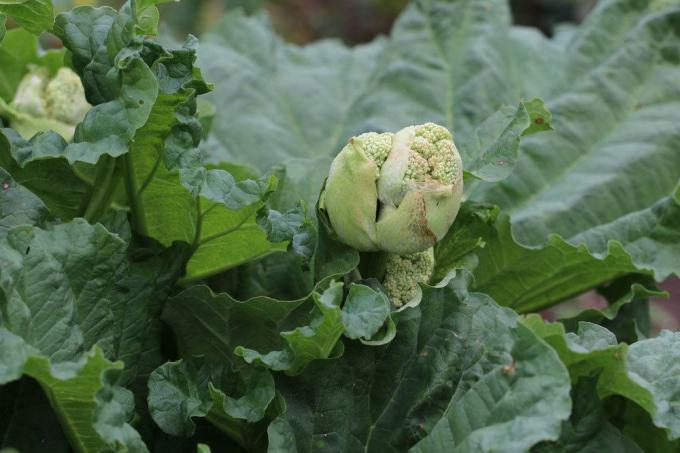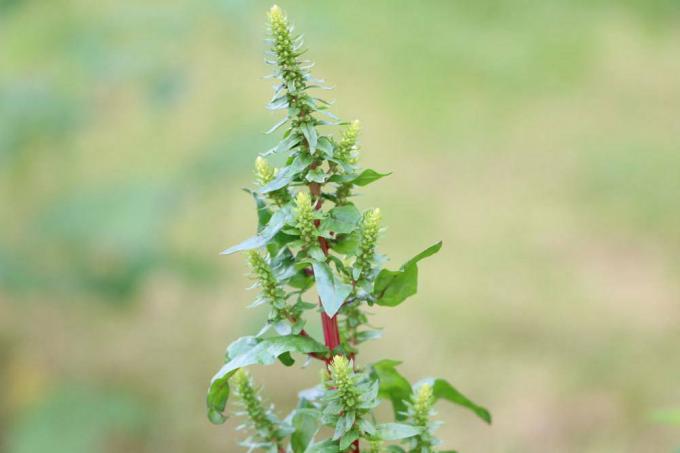
table of contents
- Rhubarb flowering period
- Rhubarb flowers
- Toxicity
- edibility
- Store rhubarb flowers
- Remove the rhubarb blossom
Many hobby gardeners ask themselves what they should actually do with the flowers of the rhubarb. Because the misconception persists that the plant becomes poisonous when it flowers. We clarify whether the flowers of the Rheum rhabarbarum are actually poisonous or even edible and at the same time explain why cutting off the flowers is not recommended!
Rhubarb flowering period
Basically, the rhubarb season ends on the 24th. June, because after that the St. John's shoot begins. This is a second growth spurt in which the plant gathers strength for the winter and the next year. The first flowers often form at this time, provided the plant was previously exposed to a permanent cold stimulus. This process is called vernalization and means for the rhubarb that it should be exposed to temperatures of a maximum of 10 ° C for around 12-16 weeks. After this cold treatment, the plant blooms and forms a panicle inflorescence with a multitude of cream-colored flowers.

Rhubarb flowers
The rhubarb forms its flowers primarily to attract insects and thus promote its reproduction. The cream-colored rhubarb flowers have easily accessible pollen and a particularly tasty nectar, which is why they are particularly popular with bees and bumblebees. As soon as the Rheum rhabarbarum blooms, it attracts numerous insects and ensures food for them. The pretty rhubarb flowers are not only interesting for insects, because humans can also use them:
- are suitable as decoration
- Flowers are edible
- can be processed into dishes
Toxicity
Are rhubarb flowers poisonous?
Unfortunately, to this day there is a false rumor that rhubarb becomes poisonous with the onset of flowering. This misconception is justified with the increasing content of Oxalic acidwhich is lowest in May and April and highest from June. Oxalic acid is an odorless and tasteless substance, which can lead to problems in the human body:
- binds calcium and prevents the absorption of iron
- promotes rheumatism and kidney stones
- bad for the joints
- attacks the tooth enamel
However, it is often not taken into account that most of the oxalic acid is found in the leaves and in the bark of the stems. However, the concentration of oxalic acid is in the other parts of the plant and thus also in the rhubarb flowers harmless. Apart from that, a toxic effect from the consumption of rhubarb is almost impossible. According to scientists, poisoning occurs after consumption of about 5000 milligrams of oxalic acid. If you consider that 100 grams of rhubarb contain around 150 to 500 milligrams of oxalic acid, the following calculation results:
- an adult (around 60 kg) would have to consume around 36 kg
- a child (around 20 kg) would have to eat around 12 kg

edibility
Rhubarb flowers are edible!
The harvested flowers can be distributed around the house for decoration or processed into tasty dishes. In terms of taste, the flowers resemble broccoli or cauliflower, although the taste is usually described as a bit more acidic. The flowers can be used in a wide variety of dishes, although it is advisable to experiment a little. Among other things, the following dishes can be prepared from the rhubarb flowers:
- baked rhubarb flowers
- double rhubarb flowers
- Baked rhubarb blossoms with tomato sauce
- sweet dishes
Store rhubarb flowers
Freshly harvested rhubarb is best processed or preserved directly. Because the shelf life of Rheum rhabarbarum is limited to a few days. For short-term storage, it is advisable to wrap the plant parts in a damp cloth and store them in the refrigerator. It is not recommended to store the flowers in aluminum foil or in containers made of aluminum. Because the flowers contain oxalic acid in harmless concentrations, which reacts with aluminum and dissolves it.
Remove the rhubarb blossom
Cut off or break out?
A rhubarb in bloom is extremely decorative thanks to its cream-colored flowers. However, it is advisable to remove the rhubarb flower. Because this gives the plant more energy for the root ball and leaves. These are better supplied with nutrients, which in turn is noticeable in an increased harvest yield. But be careful: the flowers are never cut off, but carefully broken out! Because breaking out does not damage the plant as badly and also prevents the formation of mold on the cut edges. Once the inflorescences are fully mature, the flowers are broken out as follows:
- Grasp the flower with your fingers
- preferably at the base of the stem at the bottom
- Turn the flower slightly clockwise
- then pour it abundantly
Note: If you do not aim for the maximum harvest yield, but only want to harvest a few of the rhubarb stalks every now and then, you can leave the flowers on the plant without hesitation!




